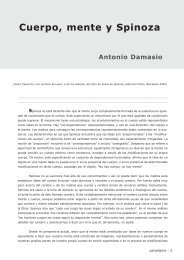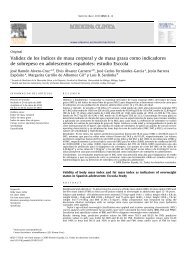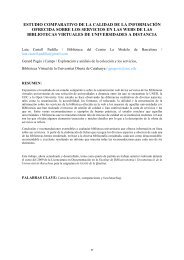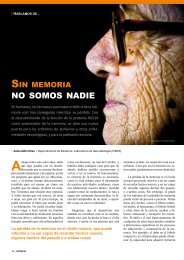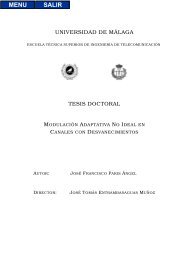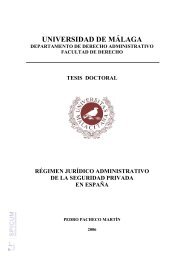Papel de las actividades superóxido dismutasa y catalasa en la ...
Papel de las actividades superóxido dismutasa y catalasa en la ...
Papel de las actividades superóxido dismutasa y catalasa en la ...
You also want an ePaper? Increase the reach of your titles
YUMPU automatically turns print PDFs into web optimized ePapers that Google loves.
1. Introduction<br />
Fish aquaculture is an expanding industry worldwi<strong>de</strong>. Marine aquaculture in<br />
southern Europe has focused on species such as gilthead seabream (Sparus aurata, L.)<br />
and sea bass (Dic<strong>en</strong>trarchus <strong>la</strong>brax, L.). However, the diversification of the species<br />
farmed is required and S<strong>en</strong>egalese sole (Solea s<strong>en</strong>egal<strong>en</strong>sis, Kaup) is a species with a<br />
high economic value, which is farmed in Portugal and Spain [1]. Diseases of bacterial<br />
origin constitute the most significant cause of economic losses suffered in the<br />
aquaculture industry [2]. The most frequ<strong>en</strong>tly iso<strong>la</strong>ted pathog<strong>en</strong> from outbreaks <strong>de</strong>tected<br />
in farmed S<strong>en</strong>egalese sole is Photobacterium damse<strong>la</strong>e subsp. piscicida, which is<br />
responsible for high mortalities in cultured fish [3]. Antibiotic treatm<strong>en</strong>t of bacterial<br />
diseases affecting farmed fish has be<strong>en</strong> applied for many years. However, the<br />
occurr<strong>en</strong>ce of antibiotic resistance in pathog<strong>en</strong>ic bacteria is limiting the usefulness of<br />
these substances [4-6] and therefore, several alternative strategies to the use of<br />
antimicrobials have be<strong>en</strong> proposed, including the use of immunostimu<strong>la</strong>nts which<br />
repres<strong>en</strong>t a promising tool in aquaculture. In<strong>de</strong>ed, many authors have reported that the<br />
injection of immunostimu<strong>la</strong>nts, such as glucans, <strong>en</strong>hances the function of leucocytes<br />
and protection against pathog<strong>en</strong>s [7-10]. Several authors have observed that P.<br />
damse<strong>la</strong>e subsp. piscicida is highly susceptible to oxidative radicals g<strong>en</strong>erated during<br />
the macrophage respiratory burst [11, 12]. However, other authors have reported the<br />
pres<strong>en</strong>ce of intact cells of this pathog<strong>en</strong> insi<strong>de</strong> fish cells, suggesting the ability of the<br />
bacterium to survive as an intracellu<strong>la</strong>r pathog<strong>en</strong> [13-17]. For this reason, the<br />
stimu<strong>la</strong>tion of the respiratory burst activity of the phagocytes of S<strong>en</strong>egalese sole could<br />
facilitate a more effective <strong>de</strong>struction of P. damse<strong>la</strong>e subsp. piscicida.<br />
Marine organisms constitute a pot<strong>en</strong>tial alternative source of substances for the<br />
prev<strong>en</strong>tion and treatm<strong>en</strong>t of infectious diseases [18]. In this connection, algae have be<strong>en</strong><br />
studied as dietary ingredi<strong>en</strong>ts for fish nutrition [19] and as a source of bioactive<br />
compounds such as pharmaceutical [20, 21] and immunostimu<strong>la</strong>nt [22-25] ag<strong>en</strong>ts.<br />
Several authors [26] have suggested a possible stimu<strong>la</strong>tion of the metabolic and<br />
functional action of phagocytic system cells from Balb/c mice after intraperitoneal<br />
administration of polysacchari<strong>de</strong>s iso<strong>la</strong>ted from cultures in the stationary phase of red<br />
3




